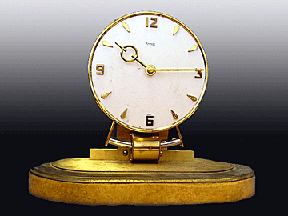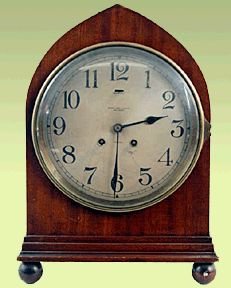|
If
you take care of your clocks, they'll give you years of service.
Follow these simple guidelines:
Care of Brass
 Fine
brass accents on time pieces should only be handled with a soft
cotton cloth. If you have to touch the weights, pendulum, etc,
wipe the touched area to remove all finger prints, smudges and
transferred oils. NEVER use abrasive cleaners as permanent damage
will result. Polishes should not be used with an any remaining
trace might work its way into the movement causing great harm .
Entrust this work only to professionals who clean, polish, and
then lacquer the parts for years of good looks. We see many items
ruined when excess polish worked its way into the delicate
mechanism where it acts like a grounding compound quickly causing
wear. Fine
brass accents on time pieces should only be handled with a soft
cotton cloth. If you have to touch the weights, pendulum, etc,
wipe the touched area to remove all finger prints, smudges and
transferred oils. NEVER use abrasive cleaners as permanent damage
will result. Polishes should not be used with an any remaining
trace might work its way into the movement causing great harm .
Entrust this work only to professionals who clean, polish, and
then lacquer the parts for years of good looks. We see many items
ruined when excess polish worked its way into the delicate
mechanism where it acts like a grounding compound quickly causing
wear.
Cleaning Glass
Avoid getting glass cleaning products on the
brass, painted, or wood surfaces. Spray the cleaner onto the
cleaning cloth (soft, clean, cotton cloths work best–an old T-shirt, etc.) and then wipe the glass surfaces on both sides.
Never spray the cleaner directly on the clock as the resulting
"cloud of chemicals" may invade the protective
environment of the mechanism. Never try to clean any glass surface
which is reverse-painted, stenciled, or decorated with a decal as
these delicate finishes may be permanently damaged. Also make sure
you know your "glass" some models of the Lecoultre Atmos
clock use both plexiglass and glass on the same unit. My customer
tried to use a thinner to remove a sticker residue which etched
and clouded what turned out to be plastic.
NEVER...
 1.
Help the weight while winding by lifting it, only raise the
weight with the crank, or a smooth and even downward pull on the
chain. 1.
Help the weight while winding by lifting it, only raise the
weight with the crank, or a smooth and even downward pull on the
chain.
2. Move a clock with a pendulum attached.
3. Polish the brass parts of a clock
4. Set a clock backward unless you know for
sure that your clock has a back-wards release setting clutch.
5. Set the hands of a clock while it is
striking as this may cause a jammed condition.
6. Swing the pendulum with excess force, or
stress the suspension spring due to heavy-handedness.
7. Try to clean the dial of a clock.
8. Wind a clock with a ill-fitting or damaged
key.
9. Wind a clock with a sizing
key.
ALWAYS...
1. Set a timepiece in the clockwise direction.
2. Wind a clock to completion.
3. Instead of winding a clock backwards, stop
it and restart it at the correct future time.
|
